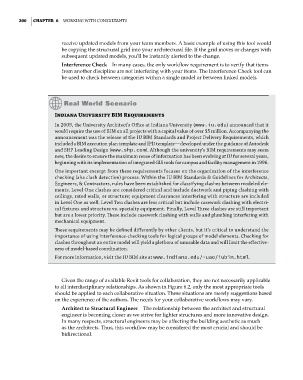Page 234 - Divyank Tyagi
P. 234
200 | ChaPter 6 Working With Consultants
receive updated models from your team members. A basic example of using this tool would
be copying the structural grid into your architectural file. If the grid moves or changes with
subsequent updated models, you’ll be instantly alerted to the change.
Interference Check In many cases, the only workflow requirement is to verify that items
from another discipline are not interfering with your items. The Interference Check tool can
be used to check between categories within a single model or between linked models.
Indiana University BIM requirements
in 2009, the university architect’s office at indiana university (www.iu.edu) announced that it
would require the use of BiM on all projects with a capital value of over $5 million. accompanying the
announcement was the release of the iu BiM standards and Project delivery requirements, which
included a BiM execution plan template and iPd template—developed under the guidance of autodesk
and shP leading design (www.shp.com). although the university’s BiM requirements may seem
new, the desire to ensure the maximum reuse of information has been evolving at iu for several years,
beginning with its implementation of integrated gis tools for campus and facility management in 1996.
one important excerpt from these requirements focuses on the organization of the interference
checking (aka clash detection) process. Within the iu BiM standards & guidelines for architects,
engineers, & Contractors, rules have been established for classifying clashes between modeled ele-
ments. level one clashes are considered critical and include ductwork and piping clashing with
ceilings, rated walls, or structure; equipment clearances interfering with structure are included
in level one as well. level two clashes are less critical but include casework clashing with electri-
cal fixtures and structure vs. specialty equipment. Finally, level Three clashes are still important
but are a lower priority. These include casework clashing with walls and plumbing interfering with
mechanical equipment.
These requirements may be defined differently by other clients, but it’s critical to understand the
importance of using interference-checking tools for logical groups of model elements. Checking for
clashes throughout an entire model will yield a plethora of unusable data and will limit the effective-
ness of model-based coordination.
For more information, visit the iu BiM site at www.indiana.edu/~uao/iubim.html.
Given the range of available Revit tools for collaboration, they are not necessarily applicable
to all interdisciplinary relationships. As shown in Figure 6.2, only the most appropriate tools
should be applied to each collaborative situation. These situations are merely suggestions based
on the experience of the authors. The needs for your collaborative workflows may vary.
Architect to Structural Engineer The relationship between the architect and structural
engineer is becoming closer as we strive for lighter structures and more innovative design.
In many respects, structural engineers may be affecting the building aesthetic as much
as the architects. Thus, this workflow may be considered the most crucial and should be
bidirectional.
c06.indd 200 5/3/2014 12:47:59 PM

